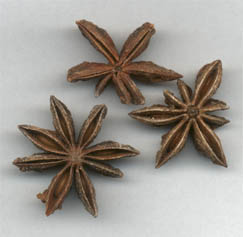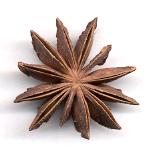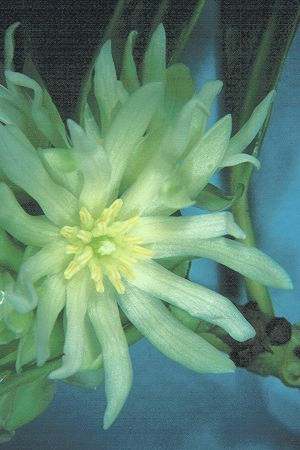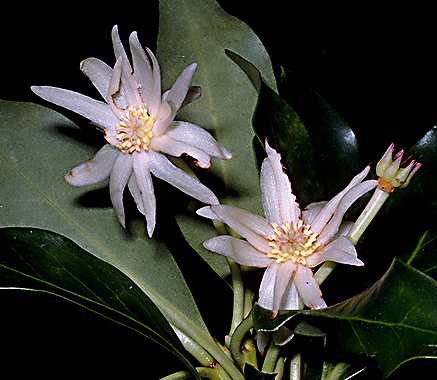
|
|
Star anise twig with flowers
www.botany.hawaii.edu © Gerald Carr |
Within this huge and heterogeneous country, a multitude of techniques for
cooking, cutting and flavouring has been developed; yet spices play a less
important part than in the cuisines of China’s southern neighbours. Common to
all regional styles is the aim to create a harmonic balance between what is
called the basic taste impressions
(wei [味]):
sweet (tian [甜] or gan [甘]),
sour (suan [酸]),
salty (xian [鹹])
and pungent (la [辣]); of lesser importance
is the bitter flavour (ku [苦]), which
is considered related to the numbing flavour of Sichuan pepper (ma [麻]).
In all other respects, regional styles differ greatly from each other.
Stir-frying (chao or chow [炒]), which is the dominating cooking technique in Chinese restaurants of the Western Hemisphere (see ginger for an example) is but one of the numerous cooking techniques in China, and it is most characteristic of the mild Cantonese style (Guangzhou [广州, 廣州] style) of cooking. Less often found in Chinese restaurants are the following two culinary styles: The rather more sweet Shanghai [上海] style is particularly known for the technique of red braising (see cassia), for which star anise is an indispensable spice. The Northern Beijing [北京] style, where rice gives way to wheat as the staple food, often prefers dry dishes which are not cooked in sauce; Beijing duck (beijing kao ya [北京烤鸭]) is a prime example. Last, the hot Sichuan [四川] style must be mentioned; today, it is highly popular all over China. In the fertile Sichuan province, people flavour their food with chiles (often in form of hot bean paste) and the indigenous Sichuan pepper; yet Sichuanese cooks make also use of orange peel, licorice, black cardamom and even local medical plants. A similar and also very spicy cuisine is found in the neighbouring Yunnan [云南, 雲南] province, which in the culinary regime is best known for its overfermented aged red tea (pu er cha [普洱茶]). Some other provinces also boast of a hot and spicy, yet unrelated, cuisine, e. g., Hunan [湖南] and Guizhou [贵州].
All over China, five spice powder (Mandarin wu xiang fen [五香粉],
Cantonese ngh heung fan [五香粉],
according to dubious sources also hung-liu)
is known and valued. This spice
mixture contains star anise, cassia (or cinnamon), cloves, fennel and Sichuan pepper
usually to equal parts. Optionally, ginger,
galanga (or more commonly lesser galanga),
black cardamom or
even liquorice may be added. These spices should be
kept whole and powdered before usage.
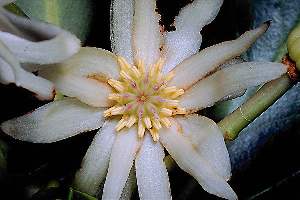
|
|
Star anise flower
www.botany.hawaii.edu © Gerald Carr |
Five spice powder is often added to a batter made from egg white and cornstarch, which is used to coat meats and vegetables to keep them moisty and succulent during deep-frying. Meat is also frequently coated with a mixture of corn starch and five spice powder and deep-fried. Lastly, it is often contained in marinades for meat to be stir-fried. Since the mixture is very aromatic, it should be used with care.
The subtle aroma of five spice powder is particularly effective in steamed foods. Steamed pork belly can indeed be a delicacy, even if it is, of course, never low in fat. For this recipe, the so-called five-flower cut is used that consists of three fatty and two lean layers. The meat is marinated in soy sauce and garlic, coated by a mixture of five-spice powder and ground, toasted rice and steamed until very tender (wu hua rou [五花肉]). This pork dish is very mild, but highly aromatic and pleasing. For more examples of star anise in Chinese cookery, see orange about the Sichuan-style beef stew au larm and cassia about master sauce.
Outside China, star anise is less valued. In the North of Vietnam, it is popular for beef soups (see Vietnamese cinnamon). Star anise is also used in Thailand: In the North, it is often employed in long-simmered stews; elsewhere, especially in the tropical South, it is a common flavourant for ice tea. Thai iced tea (cha dam yen [ชาดำเย็น]) is brewed from black tea and flavoured with star anise powder, sometimes also cinnamon, licorice, vanilla and orange flowers; it is enjoyed with crushed ice, sugar and evaporated milk. To obtain a bright orange colour, azo dyes (typically, tartrazine) are usually added.
Star anise plays some limited rôle in Persian and Pakistani (and therefrom, North Indian) cuisine. In South India it is quite common, particularly in Kerala, where it often shows up in the garam masala [ഗരം മസാലാ] spice blend (see cumin) and appears as characteristic star fragments in the local spicy adaptions of the Moghul rice dish biriyani [ബിരിയാണി] (see cardamom).
From India, star anise was also introduced to Indonesia, but is today hardly ever used save in the palaces of sultans still adhering to a Royal Indian cooking style (e. g., in Medan in the North-East of Sumatra). Star anise is also employed by the Arabic-influenced cooking of Malaysia and Southern Thailand; see coconut for an example.
Star anise has also found limited use in the West, where its main application is
as a (cheaper) substitute for anise in mulled wine,
desserts and, most importantly, in liqueurs. Most anise liqueurs (Pernod,
Anisette, Pastis) have the anise partly substituted by star anise (see also mugwort on absinthe).
